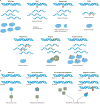Loss-of-function genetic tools for animal models: cross-species and cross-platform differences
- PMID: 27795562
- PMCID: PMC5206767
- DOI: 10.1038/nrg.2016.118
Loss-of-function genetic tools for animal models: cross-species and cross-platform differences
Abstract
Our understanding of the genetic mechanisms that underlie biological processes has relied extensively on loss-of-function (LOF) analyses. LOF methods target DNA, RNA or protein to reduce or to ablate gene function. By analysing the phenotypes that are caused by these perturbations the wild-type function of genes can be elucidated. Although all LOF methods reduce gene activity, the choice of approach (for example, mutagenesis, CRISPR-based gene editing, RNA interference, morpholinos or pharmacological inhibition) can have a major effect on phenotypic outcomes. Interpretation of the LOF phenotype must take into account the biological process that is targeted by each method. The practicality and efficiency of LOF methods also vary considerably between model systems. We describe parameters for choosing the optimal combination of method and system, and for interpreting phenotypes within the constraints of each method.
Figures


Similar articles
-
Genotype to Phenotype: CRISPR Gene Editing Reveals Genetic Compensation as a Mechanism for Phenotypic Disjunction of Morphants and Mutants.Int J Mol Sci. 2021 Mar 27;22(7):3472. doi: 10.3390/ijms22073472. Int J Mol Sci. 2021. PMID: 33801686 Free PMC article. Review.
-
First report on CRISPR/Cas9-targeted mutagenesis in the Colorado potato beetle, Leptinotarsa decemlineata.J Insect Physiol. 2020 Feb-Mar;121:104013. doi: 10.1016/j.jinsphys.2020.104013. Epub 2020 Jan 7. J Insect Physiol. 2020. PMID: 31917244
-
Manipulating plant RNA-silencing pathways to improve the gene editing efficiency of CRISPR/Cas9 systems.Genome Biol. 2018 Sep 28;19(1):149. doi: 10.1186/s13059-018-1529-7. Genome Biol. 2018. PMID: 30266091 Free PMC article.
-
Genetic compensation induced by deleterious mutations but not gene knockdowns.Nature. 2015 Aug 13;524(7564):230-3. doi: 10.1038/nature14580. Epub 2015 Jul 13. Nature. 2015. PMID: 26168398
-
A Perspective on the Future of High-Throughput RNAi Screening: Will CRISPR Cut Out the Competition or Can RNAi Help Guide the Way?J Biomol Screen. 2015 Sep;20(8):1040-51. doi: 10.1177/1087057115590069. Epub 2015 Jun 5. J Biomol Screen. 2015. PMID: 26048892 Review.
Cited by
-
Evolution of Glyphosate-Resistant Weeds.Rev Environ Contam Toxicol. 2021;255:93-128. doi: 10.1007/398_2020_55. Rev Environ Contam Toxicol. 2021. PMID: 33932185 Review.
-
Using Nanobodies to Study Protein Function in Developing Organisms.Antibodies (Basel). 2019 Feb 12;8(1):16. doi: 10.3390/antib8010016. Antibodies (Basel). 2019. PMID: 31544822 Free PMC article. Review.
-
Wash exhibits context-dependent phenotypes and, along with the WASH regulatory complex, regulates Drosophila oogenesis.J Cell Sci. 2018 Apr 13;131(8):jcs211573. doi: 10.1242/jcs.211573. J Cell Sci. 2018. PMID: 29549166 Free PMC article.
-
Drug-Inducible Control of Lethality Genes: A Low Background Destabilizing Domain Architecture Applied to the Gal4-UAS System in Drosophila.ACS Synth Biol. 2018 Jun 15;7(6):1496-1506. doi: 10.1021/acssynbio.7b00302. Epub 2018 May 15. ACS Synth Biol. 2018. PMID: 29733646 Free PMC article.
-
Glass promotes the differentiation of neuronal and non-neuronal cell types in the Drosophila eye.PLoS Genet. 2018 Jan 11;14(1):e1007173. doi: 10.1371/journal.pgen.1007173. eCollection 2018 Jan. PLoS Genet. 2018. PMID: 29324767 Free PMC article.
References
-
- Nüsslein-Volhard C, Wieschaus E. Mutations affecting segment number and polarity in Drosophila. Nature. 1980;287:795–801. - PubMed
-
- Haffter P, et al. The identification of genes with unique and essential functions in the development of the zebrafish, Danio rerio. Development. 1996;123:1–36. - PubMed
-
- Driever W, et al. A genetic screen for mutations affecting embryogenesis in zebrafish. Development. 1996;123:37–46. References 4 and 5 are leading papers that describe the first large-scale ENU screens conducted in zebrafish. - PubMed
Publication types
MeSH terms
Substances
Grants and funding
LinkOut - more resources
Full Text Sources
Other Literature Sources

